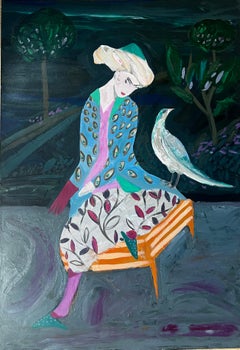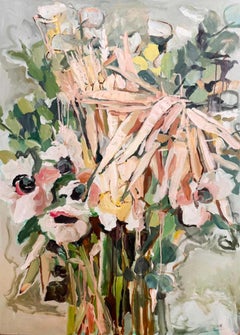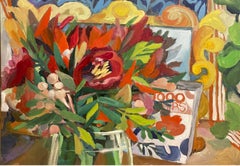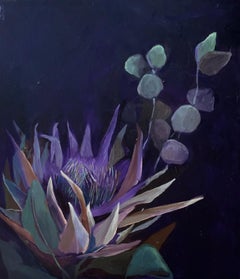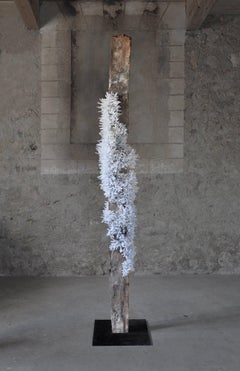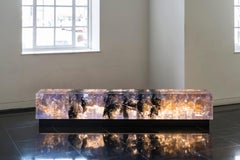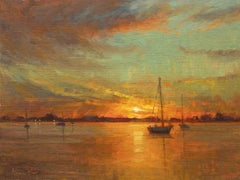More Art
2010s Contemporary More Art
Steel
21st Century and Contemporary Abstract More Art
Paper, Acrylic
21st Century and Contemporary Abstract More Art
Paper, Acrylic
2010s Contemporary More Art
Steel
Artist Comments
The radiant warmth of sunset settles over a quiet harbor. Boats rest gently on still water as brilliant golds, oranges, and soft greens ripple across the sky and sea. Distant lights shimmer along the shoreline, adding a touch of evening calm.
About the Artist
Artist Aruna Rao paints impressionistic seascapes that capture the shimmer of light, the movement of water, and the quiet poetry of coastal life. "I am endlessly inspired by how light transforms a scene, softening the atmosphere and turning an ordinary moment into something unforgettable," says Aruna. Growing up in a literary family in India, she was surrounded by stories and art, which sparked her love of narrative and visual expression. After a 20-year career in IT, she returned to painting, earning an MFA with top honors from the Academy of Art University in San Francisco. Living in Florida offers endless inspiration, from sunrise beaches and glowing horizons to quiet harbors and small human moments that evoke joy and nostalgia. Influenced by French Impressionists and contemporary coastal painters, Aruna creates luminous works that invite the viewer to pause, breathe, and rediscover the beauty of the present moment. When she is not painting, she enjoys beach walks, discovering music, watching films with her husband, and spending time with their two cats.
Words that describe this painting: sunset, harbor, sailboat, Brent Cotton...
21st Century and Contemporary Impressionist More Art
Oil
2010s Pop Art More Art
Wood, Maple, Screen
Artist Comments
People wander along the shoreline in an easy, unhurried rhythm. The wide stretch of sand, blue sky, and fresh salt air evoke the simple pleasure of a beach day....
21st Century and Contemporary Impressionist More Art
Oil
Artist Comments
Artist Aruna Rao captures the peaceful stillness of a sunlit dune path leading toward the open sea. Warm grasses glow in the gentle light, while a soft sky and ...
21st Century and Contemporary Impressionist More Art
Oil
1980s Pop Art More Art
Photographic Paper, Pencil, Graphite
1960s Modern More Art
Lithograph
Artist Comments
Artist Onelio Marrero captures a father and son discussing artwork in a gallery at the Metropolitan Museum of Art. He loves visiting museums as much for the pat...
21st Century and Contemporary Impressionist More Art
Oil
Artist Comments
Artist John Jaster captures a Southwestern landscape framed by two towering saguaro cacti and a dry creek bed winding through weathered cliffs. Vivid green and ...
21st Century and Contemporary Pop Art More Art
Acrylic
1960s Modern More Art
Lithograph
2010s Contemporary More Art
Canvas, Oil
21st Century and Contemporary Contemporary More Art
Resin
1960s Modern More Art
Lithograph
21st Century and Contemporary More Art
Canvas
Artist Comments
This contemporary painting of Boulders Beach presents a stylized, painterly interpretation of the coast. On the left, a rocky cliff descends toward the beach, m...
21st Century and Contemporary Contemporary More Art
Acrylic
2010s Contemporary More Art
Ceramic
2010s Abstract More Art
Canvas, Mixed Media, Acrylic
1960s Modern More Art
Lithograph
2010s Contemporary More Art
Textile, Cotton
2010s Pop Art More Art
LED Light, Neon Light
21st Century and Contemporary Contemporary More Art
Plastic, Color
21st Century and Contemporary Abstract Expressionist More Art
Canvas, Acrylic
1960s Modern More Art
Lithograph
Artist Comments
Soft light hits two peaks, casting soft, blue shadows on the cliffs below. In the foreground, a meadow lights up with small, dancing trees. The composition and ...
21st Century and Contemporary Expressionist More Art
Oil
Artist Comments
A stream winds between green fields, with a small patch of white in its blue water reflecting the clouds above. Trees in the distance add vertical contrast, whi...
21st Century and Contemporary Impressionist More Art
Acrylic
2010s Contemporary More Art
Canvas, Acrylic
21st Century and Contemporary Abstract More Art
Paper, Acrylic
2010s Pop Art More Art
LED Light, Neon Light
21st Century and Contemporary Abstract Impressionist More Art
Canvas, Linen, Oil
19th Century More Art
Marble, Bronze
1970s Pop Art More Art
Screen
Artist Comments
A powerful buffalo strides into view, its massive form radiating strength and dignity. In this oil painting, artist Karen Barton captures not only the animal’...
21st Century and Contemporary Impressionist More Art
Oil
1960s Modern More Art
Lithograph
21st Century and Contemporary Contemporary More Art
Adhesive, Color
21st Century and Contemporary Contemporary More Art
Wool
2010s Contemporary More Art
Lithograph, Offset
Artist Comments
Artist Onelio Marrero captures a moment inside an antiques shop, where a man browses lamps, pictures, and replicas of Frederic Remington bronzes. The interior i...
21st Century and Contemporary Impressionist More Art
Oil
2010s Contemporary More Art
Cotton, Paper, Mixed Media, Screen
Late 19th Century More Art
Terracotta
Artist Comments
A golden light sweeps across the lowlands as the sun sets. Warm hues of ochre, red, and green sparkle in the last light of day. A path meanders past the pond an...
21st Century and Contemporary Impressionist More Art
Oil
21st Century and Contemporary Abstract More Art
Paper, Acrylic
2010s Abstract More Art
Canvas, Acrylic, Glitter
1990s Contemporary More Art
Lithograph, Offset
1980s Contemporary More Art
Lithograph, Offset
2010s Contemporary More Art
Steel
Artist Comments
This oil painting captures the quiet beauty of a Florida marsh. Palm trees and billowing clouds add depth and balance to the composition. Artist Kent Sullivan u...
21st Century and Contemporary Realist More Art
Oil
21st Century and Contemporary Abstract More Art
Acrylic, Canvas
Artist Comments
The painting shows a docent in the interior of Fonthill Castle in Pennsylvania. The entire castle features exquisite handmade tiles embedded in the concrete con...
21st Century and Contemporary Impressionist More Art
Oil
Early 2000s Street Art More Art
Lithograph
1990s Contemporary More Art
Lithograph, Offset
Artist Comments
A woman sits outside a Philadelphia bistro, reading her book. The bright morning light shines through the establishment's windows, revealing a glimpse of its i...
21st Century and Contemporary Impressionist More Art
Oil
1960s Pop Art More Art
Mixed Media, Offset
2010s Contemporary More Art
Canvas, Acrylic
2010s Abstract More Art
Canvas, Acrylic
2010s Contemporary More Art
Lithograph, Offset
Artist Comments
The moon casts a soft glow over the snowy landscape. A jackrabbit’s sudden flight disrupts the stillness of the winter night. Gentle strokes and muted tones...
21st Century and Contemporary Impressionist More Art
Oil
1950s Modern More Art
Ceramic
